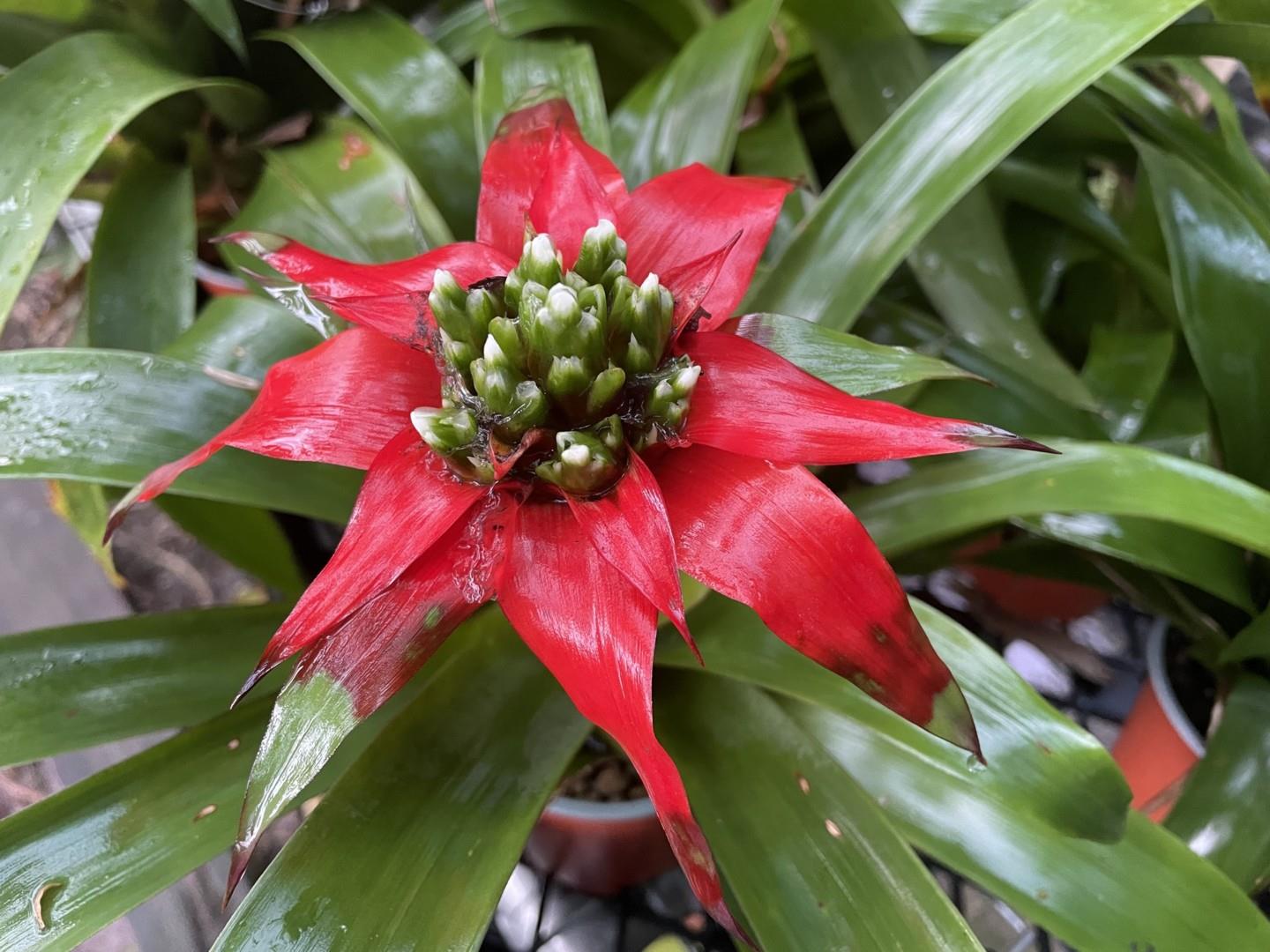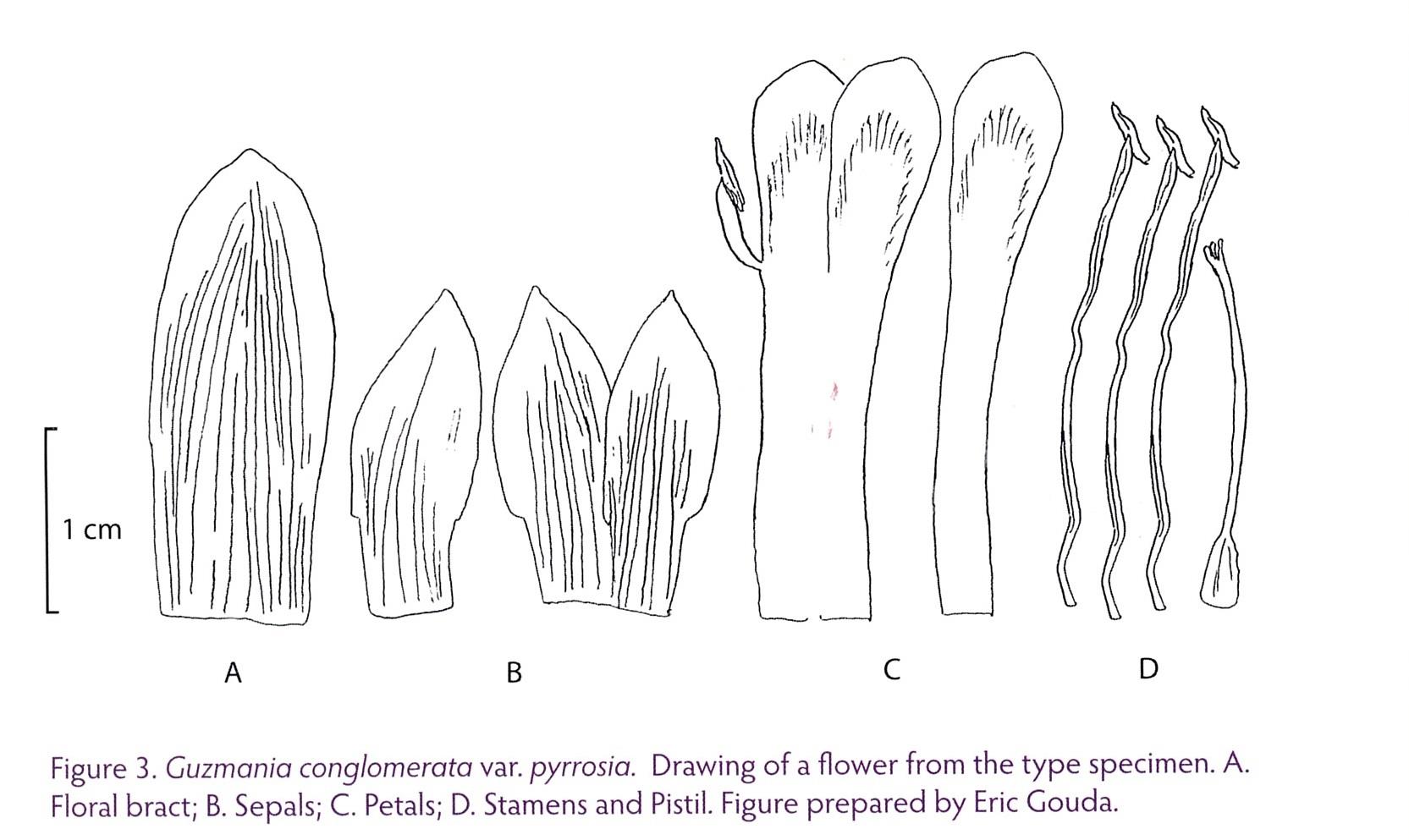


GUZMANIA CONGLOMERATA H. Luther, sp. nov.
TYPE: Ecuador, Los Rios: Montanas de Ila, path following the ridgeline at El Centinela, 600 m elev. 15 July 1979, C. H. Dodson, M. Fallen & P. Morgan 8423 (Holotype: SEL).
A G. longibracteata Betancur & Salinas sed spicis inflorescentia brevis, paucifloris, obovatisque non strobiliformis et bracteis florigeris viridis et albis non rubris et flavis differt.
Plant an epiphyte, flowering to 0.6 m tall, usually clustering.
Leaves densely rosulate, spreading, 4-7 dm long, inconspicuously appressed lepidote throughout, dark green adaxially, purple-red abaxially;
leaf sheaths elliptic, 6-10 cm long, 6 cm wide, very dark castaneous toward the base;
leaf blades ligulate, acute, 2-4 cm wide.
Scape erect to decurved, 6-12 cm long, conspicuously exserted above the leaf sheaths, much shorter than the leaf blades;
scape bracts erect, densely imbricate, the uppermost involucrate about the inflorescence, green to bright red.
Inflorescence densely digitate with 5 to 12 branches;
primary bracts ovate to elliptic, acute, 4-8 cm long, bright red;
spikes sessile, obovate, 4-6 cm long, 6 to 10-flowered, often exuding mucous;
floral bracts densely imbricate, erect, elliptic, broadly acute, 2-3 cm long, very thin, glabrous, green tipped white;
flowers short pedicellate, erect;
sepals elliptic, acute, 20-25 mm long, ca. 1/3 connate, glabrous, thin, nerved, green;
corolla erect, tubular;
petals ligulate, obtuse, 3-4 cm long, 2-5 mm connate, white.
Fruit a dry capsule.
Seed coma brown.
Guzmania conglomerata seems most closely related to G. longibracteata Betancur & Salinas (2003) from eastern Colombia. It differs most conspicuously by having the inflorescence branches obovate vs. strobiliforme to cylindric, 4-6 cm long vs. 6-9 cm long and 6 to 10-flowered vs. 15 to 30-flowered. Also the floral bracts of G. conglomerata are green tipped with white, not red tipped yellow. This new species superficially resembles the widespread G. lingulata (L.) Mez but that species has a simple inflorescence. Guzmania conglomerata is a member of the "G. morreniana group" of Betancur and Salinas (2003); see that paper for a synopsis but be aware that G. eduardii as defined there is the new G. conglomerata. Also be aware that all twentieth century illustrations and nearly everything written about G. eduardii refer to G. conglomerata or to a mixture of characters from both species. For instance, Rauh (1989) illustrated and described Guzmania conglomerata (as G. eduardii) for the first time for journal readers.
Guzmania eduardii has probably not been in cultivation for a century. It appears to be restricted to eastern Colombia and perhaps to western central Ecuador, according to Jose Manzanares, (pers. comm.). In contrast, G. conglomerata is widespread in western Ecuador and Colombia in the biogeographic region of the Choco. Because G. eduardii is so poorly known it is difficult to know anything about its relationships within Guzmania; perhaps it is related to G. sanguinea.
Guzmania conglomerata H. Luther (2006) var. pyrrosia Gouda var. nov. Figs. 1-6. J Brom Soc. 68(2): 68-72. 2019
Introduction by Eric Gouda & Jeffrey Kent
There are about 218 species and 25 infraspecific taxa recognized in Guzmania at present (Gouda et. al., cont. upd.) Many were described as new over the last 30 years, with 56 new species (ca. 25% of the total number known today) described by the late Harry Luther, often together with Karen Norton.
Locating primary forest is becoming increasingly difficult in the western Andes of Colombia. Fortunately, since the termination of the Colombian Civil War, areas which were occupied by the FARC and the ELN are now available for exploration after nearly 50 years. In one such niche, we were able to find this new form of Guzmania conglomerata alongside the road without much hiking.
Diagnosis: This new variety differs from the type variety mainly in coloration, often having more scarlet involucre bracts (vs. deep cherry red); yellow floral bracts fading to whitish at apex (vs dark green and contrasting white apex); yellow petals with white apex and margins (vs. wholly white).
Type: Colombia, Antioquia, on the road from Nutibara to the coast in the dense rainforest, 1600 m elev, cultivated and flowered Aug. 2018, Jeffrey Kent s.n. (holotype U, isotype COL).
Plant flowering 30 cm tall, forming an open rosette of about 35 leaves.
Leaves 34-49 cm long;
sheath ca. 15 x 7.5 cm, elliptic, coriaceous, much thinner at the margins in upper half, slightly contracted into the blade, densely punctulate lepidote, brown in lower half to nearly castaneous-black near the base abaxially;
blade ligulate, divergent, the upper part recurving, 4-4.6 mm wide, widest above the middle, coriaceous, canaliculate, triangular attenuate then fleshy acuminate, adaxially dark green, abaxially dark vinaceous except toward the apex, sparsely punctulate lepidote at both sides.
Inflorescence not exceeding the leaves, once-branched with ca. 8 conglomerate branches, 7 cm 1ong, 10-20 cm across including the involucral bracts, 7 x 5 cm without.
Peduncle 16 cm long, 8 mm in diameter, becoming thicker (11 mm) at distal end, pale green, glabrous, hidden by bracts;
peduncle bracts the lower ones (4) foliaceous, rapidly diminishing in size, sub-erect with spreading blades, the upper 12-14 x 4 cm, narrowly ovate, fleshy acuminate, becoming bright orange-red from a pale yellow base and the lower with a large green apical part to vinaceous at the extreme apex, massed below the inflorescence and forming an involucre, the inner involucre bracts and primary bracts orange to yellow.
Axis short, c . 1.5 cm long;
primary bracts 6 x 2.7 cm, oblong-elliptic, chartaceous at base to coriaceous and yellow and orange in upper half, the triangular attenuate and canaliculate apical part strongly curved backward (outward);
branches fasciculate, slightly complanate, short (4-7 mm) stipitate, 4-5 x 1.5-2.5 cm, sub-ellipsoid, 8-13 flowered, the ultimate one the largest;
rachis ca 1 cm long.
Floral bracts much exceeding the sepals, reaching halfway up the petals, 26-30 x 11-12 mm, oblong, imbricate, strongly incurved especially at base, even, chartaceous, glabrous or inconspicuously punctulate lepidote adaxially, cucullate incurved at apex, obtuse, bluntly carinate at apex (beaked), the outer ones sometimes also to the base, yellow to greenish toward base and whitish at the apex.
Flowers erect; receptacle 2 x 5 mm, white, lustrous, bi-angled;
sepals glabrous, even, unequal in length, ca. 18 x 8 mm, elliptic, the basal 5 mm connate, the free part ovate, fleshy coriaceous, with hyaline margins and apex, yellow in lower 3/4;
petals 3.2 x 0.5 cm, ligulate, yellow with white apex and margins, rounded, slightly cucullate, conglutinate and adnate to the filaments for ca. 2 cm.
Stamens included, 2.7 cm long;
filaments flaccid, yellow, free part dilated to 1 mm in diameter, complanate;
anthers 4 mm, whitish, minutely apiculate, dorsifixed at center;
pollen whitish.
Pistil 21 mm long
ovary 5 x 2.5 mm, sub-cylindrical, contracted into the style, cream colored to green;
style slender, yellow;
stigma with undulate margins, erect conduplicate, white.
Etymology: from the Greek "pyros", flame-coloured, because the bright orange red and yellow bracts and flowers remind one of flames.
Observations: Seeds of Guzmania conglomera var. pyrossia were collected on the road from Nutibara to the coast in the dense rainforest at 1600 msm, Northwestern Colombia, and grown in the nursery of the second author. Associated with this new variety were Guzmania carminea??, Guzmania hollinensis H. Luther (1992) and Guzmania skotakii H. Luther (1991). The type variety was described from Central western Ecuador, Los Rios, but is also found in the provinces of Esmiraldas and Imbabura, Ecuador. Several specimens collected from Antioquia, Colombia have been identified as this species, but it is unknown if they all belong to this new variety or whether the type variety also grows in Colombia.
Distribution and habitat: This variety is only known from Colombia, in the state of Antioquia, where it grows as an epiphyte in the understory of a mountain forest at about 1600 m elevation. Its distribution is limited to the forest remnants which can be found throughout the western part of the state bordering the Pacific Ocean.
Cultivation notes: This new variety seems to be well suited to growing in colllections. It does not require much light but prefers a humid environment and is very showy, keeping the coloration for a long period of time.